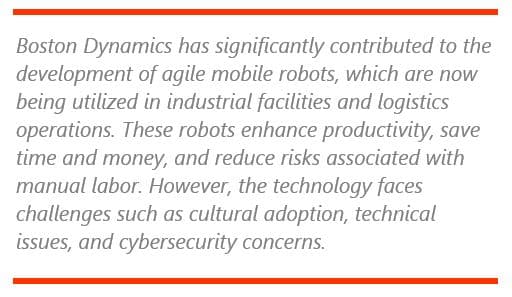

Keywords: Boston Dynamics, Agile Mobile Robots, Spot, Stretch, Productivity, Autonomous Tasks, Wireless Communications, Cybersecurity, Cultural Adoption, Workforce Implications: ARC Advisory Group.
Boston Dynamics is revolutionizing industries with their agile mobile robots, Spot and Stretch, which are used for autonomous repetitive tasks in industrial facilities and logistics operations. These robots  increase productivity by performing heavy-lifting tasks and can remotely operate, saving time and money for companies. Challenges faced by the technology include cultural adoption, wireless communications, and cybersecurity concerns. Despite these challenges, the use of robots has several implications for owner-operators and technology users, leading to increased productivity, cost savings, and improved workplace safety.
increase productivity by performing heavy-lifting tasks and can remotely operate, saving time and money for companies. Challenges faced by the technology include cultural adoption, wireless communications, and cybersecurity concerns. Despite these challenges, the use of robots has several implications for owner-operators and technology users, leading to increased productivity, cost savings, and improved workplace safety.
Boston Dynamics has made considerable strides in the field of robotics, developing agile mobile robots such as Spot and Stretch. These robots have been commercialized and are currently being used for autonomous repetitive tasks in industrial facilities and logistics operations. Their ability to operate remotely not only saves time and money for companies but also eliminates the need for employees to travel to remote locations to perform tasks. The technology is helping industries increase productivity by taking on heavy-lifting and repetitive tasks, thus allowing employees to focus on more engaging work. However, several challenges are still being faced in the process of adopting these robots in various industries.
The challenges faced by the adoption of Boston Dynamics' agile mobile robots include cultural adoption, technical issues, and cybersecurity concerns. Cultural adoption is particularly difficult in industries where jobs were traditionally performed by humans, and the sight of robots may attract skepticism. It is essential for companies to carefully assess their workforce and develop strategies to integrate robots without disrupting the work environment.
Technical challenges such as the need for wireless communications can slow down the adoption process. Stable and secure wireless connections are crucial for the efficient operation of these robots, and companies need to invest in the necessary infrastructure to ensure seamless communication. Additionally, addressing cybersecurity concerns is crucial to ensure the safety of these robots in the workplace. Companies need to invest in cybersecurity measures and establish protocols to protect their robots from potential threats.
Another challenge lies in the fact that companies must invest in new technologies and equipment to support the robots, and employees must learn new skills to operate and manage them. This may require significant investment in employee training and development, as well as the reorganization of workplace structures. Furthermore, the need for continuous research and development in robotics can add to the challenges faced by companies trying to keep up with the rapidly evolving technology.
ARC Advisory Group clients can view the complete report at ARC Client Portal
Please Contact Us to speak with the author.
Obtain more ARC In-depth Research at Market Analysis
Learn more about ARC Strategic Services at Advisory Services for Industry Leaders

